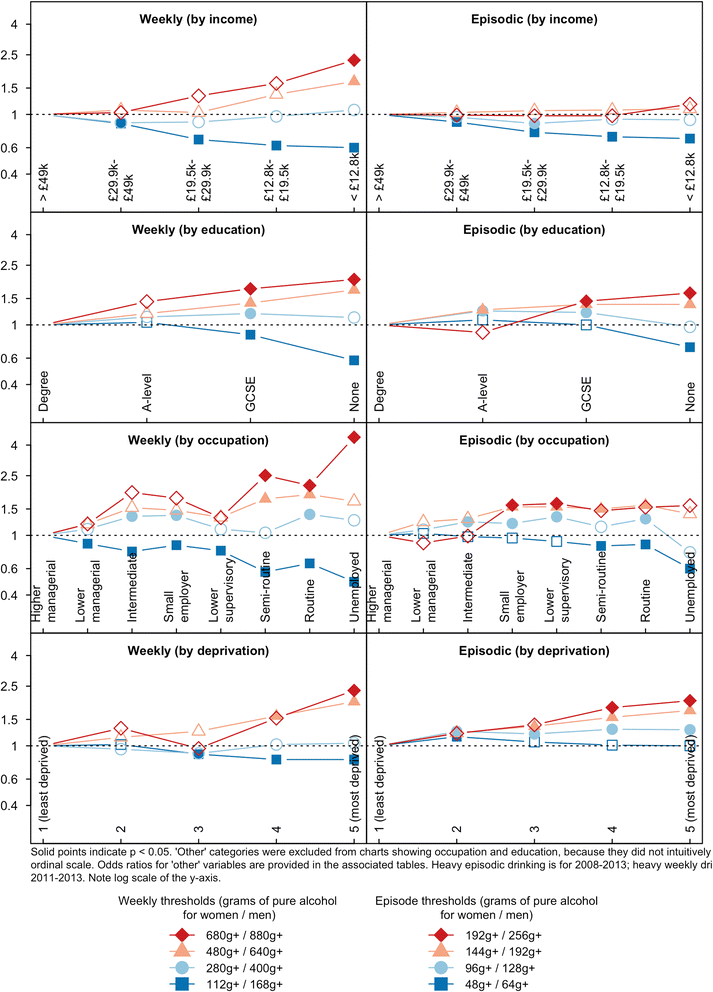Unravelling the alcohol harm paradox: a population-based study of social gradients across very heavy drinking thresholds
- PMID: 27430342
- PMCID: PMC4950253
- DOI: 10.1186/s12889-016-3265-9
Unravelling the alcohol harm paradox: a population-based study of social gradients across very heavy drinking thresholds
Abstract
Background: There is consistent evidence that individuals in higher socioeconomic status groups are more likely to report exceeding recommended drinking limits, but those in lower socioeconomic status groups experience more alcohol-related harm. This has been called the 'alcohol harm paradox'. Such studies typically use standard cut-offs to define heavy drinking, which are exceeded by a large proportion of adults. Our study pools data from six years (2008-2013) of the population-based Health Survey for England to test whether the socioeconomic distribution of more extreme levels of drinking could help explain the paradox.
Methods: The study included 51,498 adults from a representative sample of the adult population of England for a cross-sectional analysis of associations between socioeconomic status and self-reported drinking. Heavy weekly drinking was measured at four thresholds, ranging from 112 g+/168 g + (alcohol for women/men, or 14/21 UK standard units) to 680 g+/880 g + (or 85/110 UK standard units) per week. Heavy episodic drinking was also measured at four thresholds, from 48 g+/64 g + (or 6/8 UK standard units) to 192 g+/256 g + (or 24/32 UK standard units) in one day. Socioeconomic status indicators were equivalised household income, education, occupation and neighbourhood deprivation.
Results: Lower socioeconomic status was associated with lower likelihoods of exceeding recommended limits for weekly and episodic drinking, and higher likelihoods of exceeding more extreme thresholds. For example, participants in routine or manual occupations had 0.65 (95 % CI 0.57-0.74) times the odds of exceeding the recommended weekly limit compared to those in 'higher managerial' occupations, and 2.15 (95 % CI 1.06-4.36) times the odds of exceeding the highest threshold. Similarly, participants in the lowest income quintile had 0.60 (95 % CI 0.52-0.69) times the odds of exceeding the recommended weekly limit when compared to the highest quintile, and 2.30 (95 % CI 1.28-4.13) times the odds of exceeding the highest threshold.
Conclusions: Low socioeconomic status groups are more likely to drink at extreme levels, which may partially explain the alcohol harm paradox. Policies that address alcohol-related health inequalities need to consider extreme drinking levels in some sub-groups that may be associated with multiple markers of deprivation. This will require a more disaggregated understanding of drinking practices.
Figures
Similar articles
-
Effects of minimum unit pricing for alcohol on different income and socioeconomic groups: a modelling study.Lancet. 2014 May 10;383(9929):1655-1664. doi: 10.1016/S0140-6736(13)62417-4. Epub 2014 Feb 10. Lancet. 2014. PMID: 24522180 Free PMC article.
-
The Relationship Between Drinking Pattern, Social Capital, and Area-Deprivation: Findings From the Health Survey for England.J Stud Alcohol Drugs. 2017 Jan;78(1):20-29. doi: 10.15288/jsad.2017.78.20. J Stud Alcohol Drugs. 2017. PMID: 27936361
-
Exploring the characteristics of newly defined at-risk drinkers following the change to the UK low risk drinking guidelines: a retrospective analysis using Health Survey for England data.BMC Public Health. 2019 Jul 8;19(1):902. doi: 10.1186/s12889-019-7240-0. BMC Public Health. 2019. PMID: 31286928 Free PMC article.
-
The role of alcohol use and drinking patterns in socioeconomic inequalities in mortality: a systematic review.Lancet Public Health. 2020 Jun;5(6):e324-e332. doi: 10.1016/S2468-2667(20)30052-9. Lancet Public Health. 2020. PMID: 32504585
-
Socioeconomic status and alcohol use in low- and lower-middle income countries: A systematic review.Alcohol. 2018 Aug;70:23-31. doi: 10.1016/j.alcohol.2017.12.002. Epub 2017 Dec 27. Alcohol. 2018. PMID: 29723827
Cited by
-
Is there a safe limit for consumption of alcohol?J Hepatol. 2025 Mar;82(3):535-540. doi: 10.1016/j.jhep.2024.10.024. Epub 2024 Nov 1. J Hepatol. 2025. PMID: 39489179 Review.
-
Understanding the alcohol harm paradox: A multivariable mendelian randomization approach.PLoS Genet. 2025 Aug 14;21(8):e1011824. doi: 10.1371/journal.pgen.1011824. eCollection 2025 Aug. PLoS Genet. 2025. PMID: 40811757 Free PMC article.
-
Differential Associations of Alcohol Use With Ischemic Heart Disease Mortality by Socioeconomic Status in the US, 1997-2018.JAMA Netw Open. 2024 Feb 5;7(2):e2354270. doi: 10.1001/jamanetworkopen.2023.54270. JAMA Netw Open. 2024. PMID: 38300620 Free PMC article.
-
Factors Associated with Single-Use and Co-Use of Tobacco and Alcohol: A Multinomial Modeling Approach.Int J Environ Res Public Health. 2019 Sep 20;16(19):3506. doi: 10.3390/ijerph16193506. Int J Environ Res Public Health. 2019. PMID: 31547073 Free PMC article.
-
Association between social deprivation and incidence of first seizures and epilepsy: A prospective population-based cohort.Epilepsia. 2022 Aug;63(8):2108-2119. doi: 10.1111/epi.17313. Epub 2022 Jun 10. Epilepsia. 2022. PMID: 35611982 Free PMC article.
References
-
- World Health Organization . Global status report on alcohol and health 2014. Geneva: World Health Organization; 2014.
MeSH terms
LinkOut - more resources
Full Text Sources
Other Literature Sources
Medical


